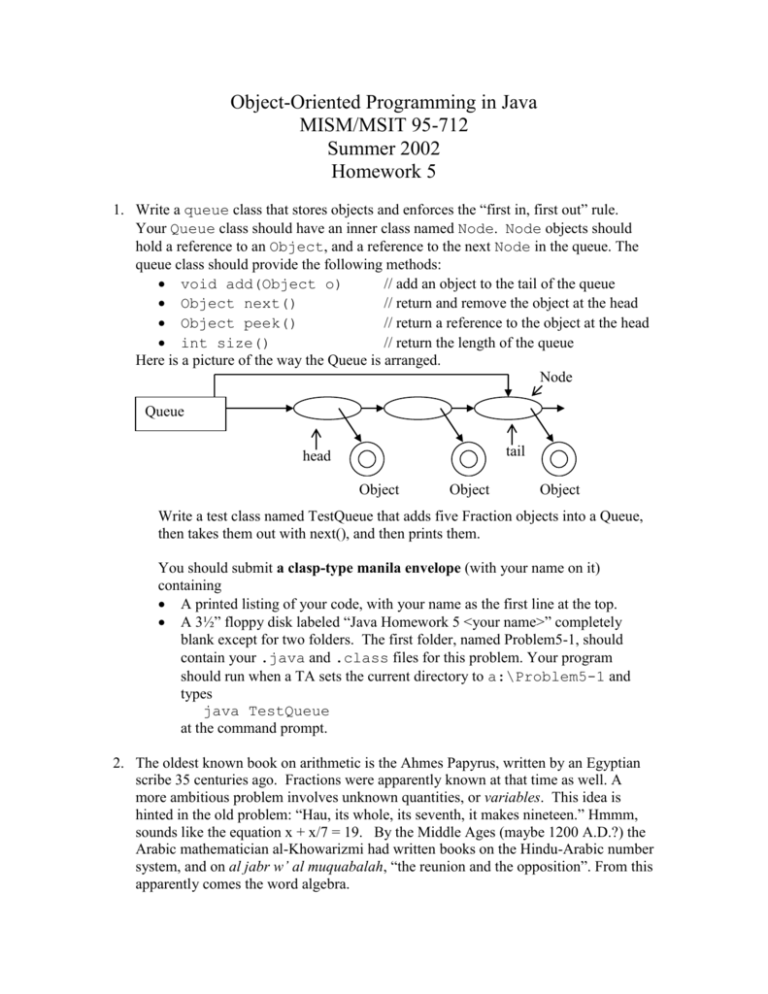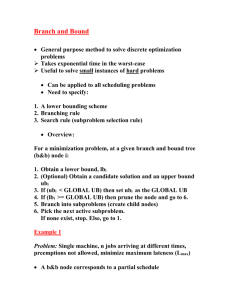Homework5
advertisement

Object-Oriented Programming in Java
MISM/MSIT 95-712
Summer 2002
Homework 5
1. Write a queue class that stores objects and enforces the “first in, first out” rule.
Your Queue class should have an inner class named Node. Node objects should
hold a reference to an Object, and a reference to the next Node in the queue. The
queue class should provide the following methods:
void add(Object o)
// add an object to the tail of the queue
Object next()
// return and remove the object at the head
Object peek()
// return a reference to the object at the head
int size()
// return the length of the queue
Here is a picture of the way the Queue is arranged.
Node
Queue
tail
head
Object
Object
Object
Write a test class named TestQueue that adds five Fraction objects into a Queue,
then takes them out with next(), and then prints them.
You should submit a clasp-type manila envelope (with your name on it)
containing
A printed listing of your code, with your name as the first line at the top.
A 3½” floppy disk labeled “Java Homework 5 <your name>” completely
blank except for two folders. The first folder, named Problem5-1, should
contain your .java and .class files for this problem. Your program
should run when a TA sets the current directory to a:\Problem5-1 and
types
java TestQueue
at the command prompt.
2. The oldest known book on arithmetic is the Ahmes Papyrus, written by an Egyptian
scribe 35 centuries ago. Fractions were apparently known at that time as well. A
more ambitious problem involves unknown quantities, or variables. This idea is
hinted in the old problem: “Hau, its whole, its seventh, it makes nineteen.” Hmmm,
sounds like the equation x + x/7 = 19. By the Middle Ages (maybe 1200 A.D.?) the
Arabic mathematician al-Khowarizmi had written books on the Hindu-Arabic number
system, and on al jabr w’ al muquabalah, “the reunion and the opposition”. From this
apparently comes the word algebra.
For this homework problem, turn the Arithmetic project from last week into the
Algebra project, by including a new class named Variable. Objects of this class
represent a variable, like X0or X4, whose value is determined sometime after it is
defined.
In the Arithmetic project, we created expressions like ((3 + 4) / (2 + 9)). We even
were able to evaluate expressions like this. Now we want to create (in the Algebra
project) expressions like ((X0 – 3.14) + (((1.3 – (X1 / 2.0)) *
(2.3 – X2))), where the expression knows how to evaluate itself if given an
array of values for X0, X1 and X2. Of course, the tree representation of the above
algebraic expression isn’t really different. It just has a new node type, the
Variable node, and can be slightly more complex than the expressions you created
before:
+
-
X0
*
3.14
-
1.3
-
/
X1
2.3
X2
2.0
But how can we evaluate a tree like this? The Xs must be given concrete values.
So, the eval() method for every Node must be given an array of values
(double[] data) so that when this array is passed down to a Variable, it
can select its value. Thus a Variable node whose index is 2 should return
data[2]. So now every method eval() must now be eval(double[]
data).
Here is the scheme. An object of the Variable class holds an integer (its
“index”) whose value says if it is an X0 or X1 or X2 or … When a Variable
object is asked to evaluate itself, it uses its index variable to look in the data
array to find its value, and returns this value. All the other Node subclasses work
just as they did before. When you write the code for this problem, make Node an
interface, as we did in class.
I mentioned in class that I wanted you to write code that would produce
expression trees of random shapes. For this assignment, I retract that
requirement, because to do it correctly requires that you add several methods to
several of the Node subclasses. We will do this later. For now, all you need to do
is create trees with the structure you produced in Homework 4, that is, balanced
binary trees with three operators and four “leaf” nodes. The only difference here
is that some of the leaf nodes may be Variables, not just Consts.
As a possible aid to you in doing this assignment, what follows is the code in my
class TestAlgebra. This is definitely not the only way to do it, but it is a
plausible way.
import java.util.*;
public class TestAlgebra {
static int numIndepVars = 3;
static Random r = new Random();
public static Node randOperator() {
Node n;
int i = r.nextInt(4);
switch(i) {
case 0: n = new Plus(); break;
case 1: n = new Minus(); break;
case 2: n = new Mult(); break;
case 3: n = new Divide(); break;
default: n = new Plus(); break;
}
return n;
}
public static Node randConst() {
Node n;
int i = r.nextInt(20) + 1;
n = new Const(i);
return n;
}
public static Node randVariable() {
Node n;
int i = r.nextInt(numIndepVars);
n = new Variable(i);
return n;
}
public static Node randConstOrVariable() {
Node n;
int i = r.nextInt(2);
if ( i == 0)
n = randConst();
else
n = randVariable();
return n;
}
public static void main(String[] args) {
double[] data = new double[3];
data[0] = 3.14;
data[1] = 2.78;
data[2] = 1.0;
for (int i = 0; i < 5; i++) {
Node root = randOperator();
Node n1 = randOperator();
n1.setChild(1, randConstOrVariable());
n1.setChild(2, randConstOrVariable());
Node n2 = randOperator();
n2.setChild(1, randConstOrVariable());
n2.setChild(2, randConstOrVariable());
root.setChild(1, n1);
root.setChild(2, n2);
String s = root.toString();
System.out.println(s + " = " +
root.eval(data));
}
}
}
With the rest of my code, this produces a typical run printing this:
((18.0 * 7.0) - (X0 * X2)) = 122.86
((19.0 - 8.0) + (19.0 + X0)) = 33.14
((X2 / X1) + (X2 / 8.0)) = 0.4847122302158274
((X2 * 6.0) / (9.0 - 10.0)) = -6.0
((X0 * X2) / (7.0 - 11.0)) = -0.785
Submit
A printed listing of your code, with your name as the first line at the top.
A folder in “Java Homework 5 <your name>” named Problem5-2,
containing your .java and .class files for this problem. Your program
should run when a TA sets the current directory to a:\Problem5-2 and
types
java TestAlgebra
at the command prompt.







